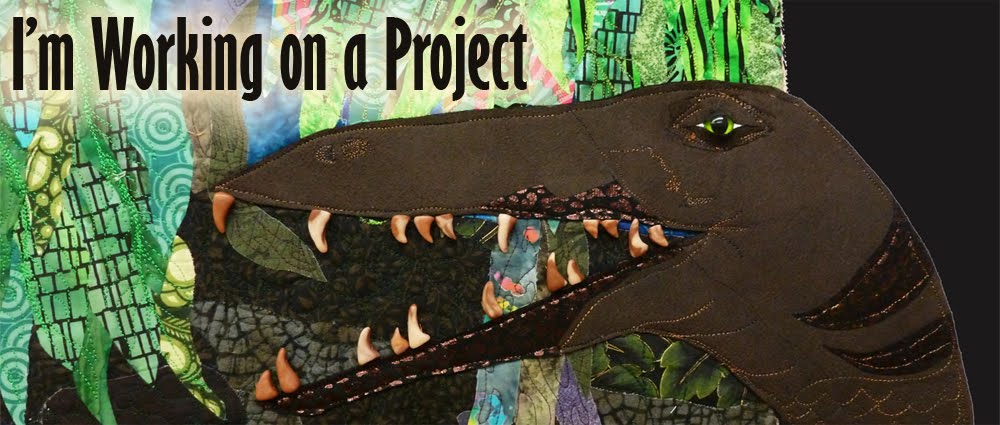I didn't want to digitally print it, so I started thinking about ways to get my handwriting onto fabric. At first I thought I'd try bleach discharge using a bleach pen, but on my little samples, the bleach pen bled so much that it wasn't really legible.
Next I thought about using Esterita Austin's ink/paint transfer technique. I'd previously used it on my seed packet quilt and thought it might work here. Basically, you can paint or write on parchment paper, layer it with misty fuse and organza and the paint/ink is picked up by the organza/misty fuse when you iron. Previously I'd done it with paint, which worked quite well, but for the handwriting I wanted to use marker as I'm not very graceful writing with a brush. I did some sharpie writing on the parchment (top picture), and then did the mistyfuse transfer onto organza (middle picture). It worked fine, but because the misty fuse has the texture of a fine webbing and the marker ink doesn't have any inherent structure to it (like a layer of paint), the ink only transfers exactly where the misty fuse fibers were. This resulted in a sort of faint transfer which wasn't exactly what I was going for. I tried it using wonder under instead of misty fuse since that's a little denser, but it really didn't work (bottom picture); I just got a big mess.
Next I decided to try sunprinting. I purchased some Jacquard SolarFast, a sunprinting fluid that allows you to print in many different colors, not just the blue of traditional cyanotypes. I got a bottle of purple and a bottle of orange. You paint it on, then while wet, put on your items for resist, cover them with glass, and put them in the sun. Many people print black and white photos on transparencies and place those under the glass for printing, so I figured I could write with a black marker and that would work. I did two small test pieces on different background fabrics. For one (Alleluia Alleluia below) I used a standard sharpie and wrote on the transparency. For the other (Go in Peace below), I wrote with standard sharpie directly on my glass. The two pictures are just different amounts of time in the sun so you can see the color develop. Writing on the glass was easier since it meant only positioning one thing, but I was concerned that because the writing was on the top of the glass, the thickness of the glass might make the writing less crisp.
Indeed that's what happened. Sorry for the terrible lighting below, I'm not sure why I had so much reflected light off these samples. Anyway, you can see that the writing is definitely crisper and easier to read in the Alleluia sample than the Go in Peace sample. In fact on the Go in Peace sample, you can hardly even see the words, especially on the purple.
I decided to use orange for the center of my print (where most of the writing would be) and purple for the outside ring since the writing was easier to see on the purple. I did like the look of the purple and orange on the light yellow print background, so I grabbed another piece of light yellow tone-on-tone from my stash. I also decided to go ahead and write on the transparency rather than the glass and use a thicker marker. The final size of my print is about 30 x 30 so that meant a large piece of glass, transparency, and fabric to line up. It was a bit tricky lining it all up in the dark, and then my giant sheet of glass broke in two leaving some very sharp edges, but in the end I got it all layered up and into the sun. Here it is mid-print. The thing that looks like a white string across the top is actually the place where the glass broke. I had to hold it together with clear packing tape. If you look closely you can see the transparencies underneath (where the writing is). The little whitish squares are the scotch tape I used to hold the transparency sheets together. Unfortunately you can't use the transparencies without the glass overlays because they blow away.
Here's how the final print turned out. I like it- the text is subtle, but legible if you look very closely, which is fine with me. I have great plans for how I want to turn this into a quilt, but sadly there are a few more high-priority things in the pipeline right now so it'll be the first of the year or later when I get back to this.
What kind of experiences have you had with these techniques?








Hi Sharon, I've done lots of solar printing but I never thought to write on a transparency! I did print some and they came out great, but I love the idea of using text this way and I love the look you achieved! Do you know you can use plexiglass?
ReplyDeleteI have never tried your technique before. I love words on fabric and need to re read your post and try something. The idea of transfer is good, what about the solvent's approach (riley) I can't be around solvents so I want to try the sun. I tried laying forks and spoons on fabric in the sun but it wasn't distinct enough. LeeAnna
ReplyDeleteif we ever see the sun again, that is
Delete